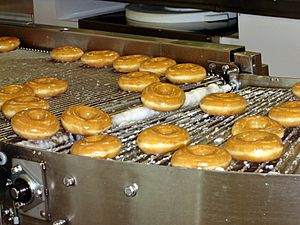Glaze (cooking technique) facts for kids
In cooking, a glaze is a shiny, often see-through layer put on the outside of food. You can put it on by dipping the food, letting the glaze drip, or brushing it on. Glazes can be added before or after cooking. They can be either sweet or savory. For example, a sweet glaze might be made from sugar, while a savory one could use meat juices. Common glazes include brushed egg whites, some kinds of icing, or even jam. They often contain ingredients like butter, sugar, milk, oil, or fruit juice.
What are some examples of glazes?
Doughnut glaze is a great example! It's usually made from a simple mix of powdered sugar and water. This sweet liquid is then poured over the doughnuts, giving them their famous shiny finish. Some pastries have a coating of egg whites brushed on them before baking, which helps them look golden and shiny. There's also something called "mirror glaze," which is so glossy you can actually see your reflection in it! Many candies and sweets are coated in edible wax glazes, often by tumbling them in a special machine.
Savory glazes are also very popular. A rich, savory glaze can be made from reduced meat stock, which is a concentrated liquid from cooking meat bones and vegetables. This thick glaze is then poured over meats or vegetables to add flavor and shine. For instance, a glazed ham might have a sweet and savory glaze put on it before baking. Sometimes, the glaze is brushed on during cooking, or even added afterward, like a brown sugar mix heated with a torch to create a crispy, sweet crust.
When did people start using glazes?
People have been using glazes in cooking for a very long time! In medieval England, a common glaze was called the 'Elizabethan' glaze. It was made from lightly beaten egg white mixed with sugar. This simple, sweet glaze was mostly used on pastries during that time, making them look more appealing and adding a touch of sweetness.


